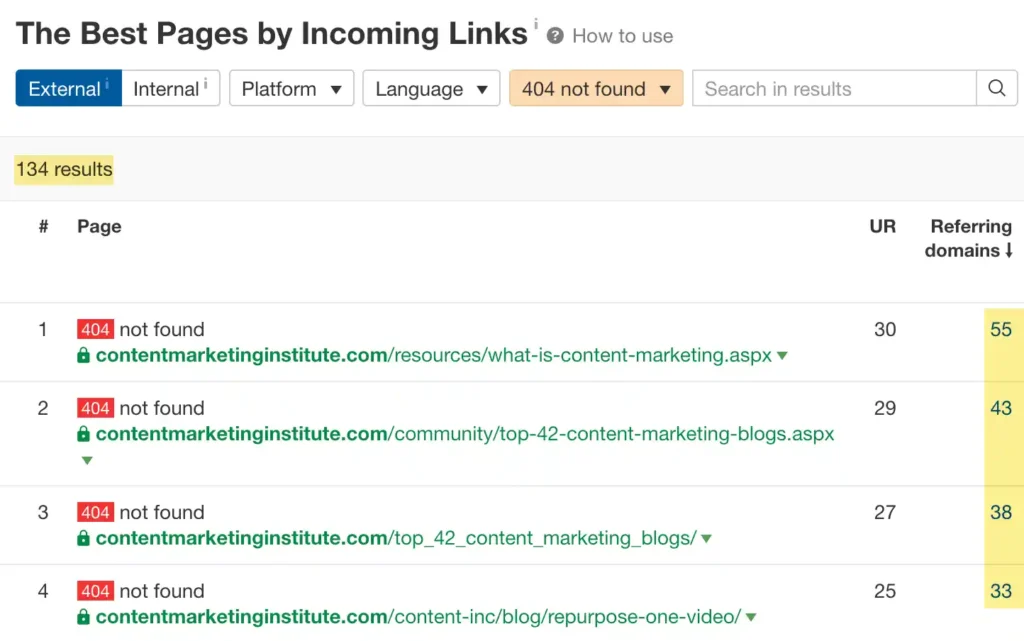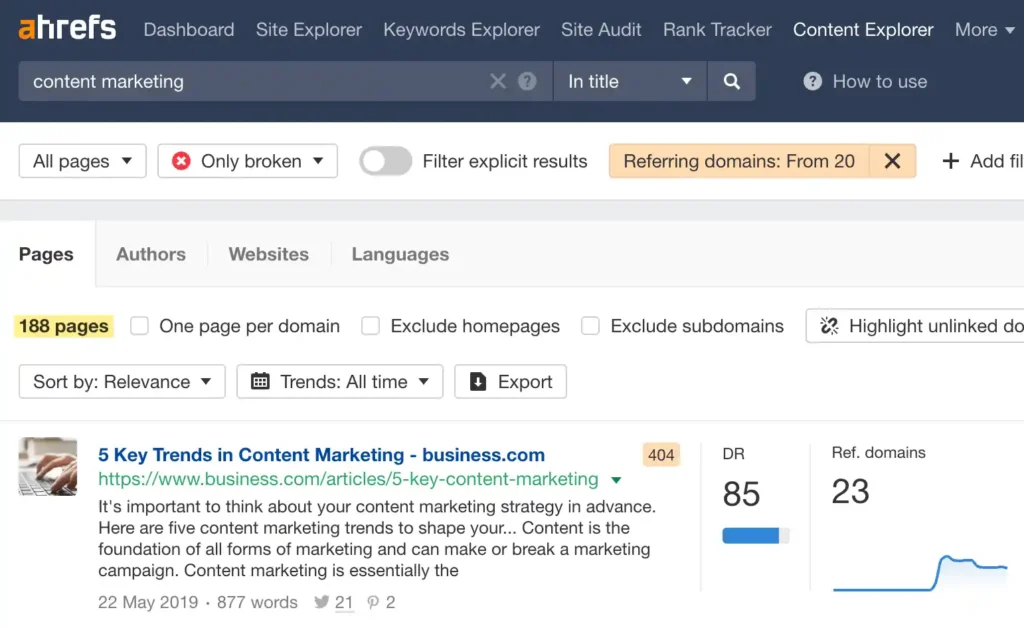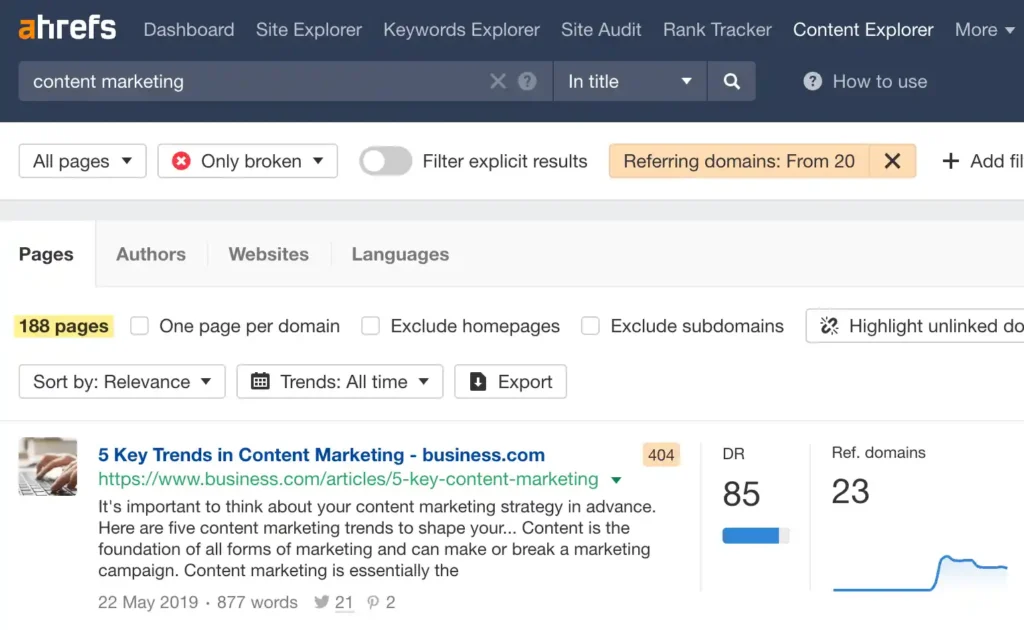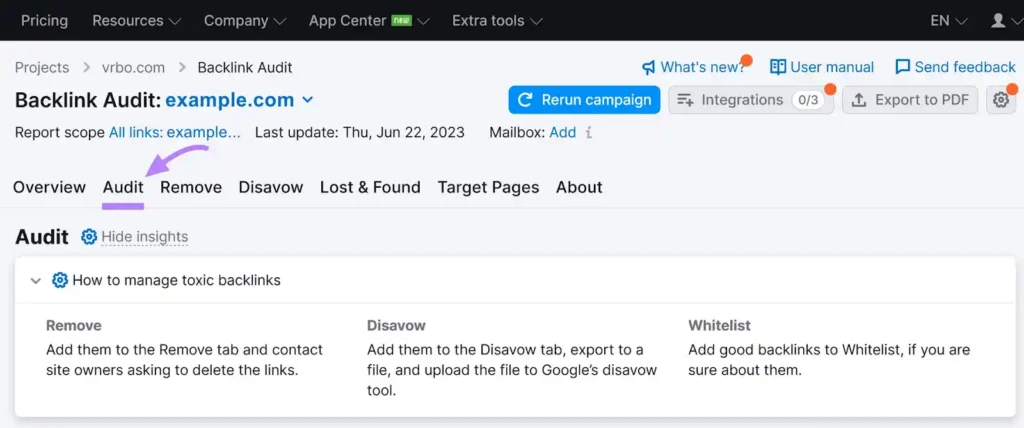Broken link building is a surprisingly effective and underutilized strategy in SEO. This technique involves finding broken or dead links on websites and offering your own content as a replacement.
Not only does it help webmasters improve the user experience by fixing broken links, but it also provides an opportunity for you to earn high-quality backlinks.
This guide will explore broken link building, why it works, and how to execute this strategy effectively.
Whether you’re a beginner or an experienced SEO professional, you’ll gain actionable tactics to improve your link profile.
Table of Contents
What Is Broken Link Building?
Broken link building is a strategic SEO tactic that involves identifying broken (404) links on external websites and offering your content as a replacement.
Websites often contain links to resources, articles, or pages that no longer exist, which results in a poor user experience.
When site owners or web admins notice these dead links, they might appreciate being informed. That is especially true if a suitable replacement can be suggested.
The process begins by prospecting websites in your niche or industry that have broken links. Once you’ve identified the dead links, you create high-quality content relevant to the broken link’s original purpose.
You then inform the website owner or webmaster about the broken link. Moreover, you suggest your content as a suitable replacement.
The major benefits of broken link building are twofold:
- It helps improve the website’s SEO by fixing broken links
- It offers an opportunity to acquire valuable backlinks
Unlike other link-building techniques, broken link building is based on providing value to the website owner. It makes it an ethical and sustainable approach.
Does Broken Link Building Work?
Many SEO experts argue that broken link building is often a waste of time. The process can be tedious, involving hours of research to find dead links, create replacement content, and send outreach emails.
Moreover, not all broken links lead to valuable opportunities, and many webmasters may not respond, resulting in a low success rate.
However, broken link building can be highly effective when you target the right link opportunities. Not all broken links are worth pursuing. Success hinges on-
- Finding links on high-authority sites within your niche
- Ensuring your replacement content is valuable and,
- Crafting personalized outreach that resonates with webmasters
When you focus on quality over quantity, broken link building can significantly enhance your link profile.
Later in this blog, we’ll discuss how to identify the best opportunities for broken link building and how to execute this strategy effectively.
How to Prospect Broken Link Building Using Ahrefs
Ahrefs is one of the most powerful tools available for broken link building. Using it, you can easily identify valuable broken link opportunities on relevant websites within your niche.
Below is a step-by-step guide on how to prospect for broken link building using Ahrefs.
Step 1: Identify Target Websites
The first step in broken link building is identifying relevant websites in your industry that may have broken links. These websites should be authoritative, have high traffic, and host content related to your niche.
To start, you can search for competitors, industry leaders, and websites that consistently publish content relevant to your field.
In Ahrefs, you can search for these websites using the Site Explorer tool.

By entering a competitor’s website URL, you can view its backlink profile. This will let you identify the high-ranking pages that could be potential candidates for broken link building.
Additionally, you can analyze their referring domains to uncover more authoritative websites that may offer broken link opportunities.
Step 2: Use Ahrefs to Find Broken Links
Once you’ve identified some target websites, the next step is to find the actual broken links. This is where Ahrefs’ Site Audit tool comes into play.
Site Audit crawls a website’s pages, identifies broken links (404s), and provides a list of all issues found on the site.
- Set Up a New Project: Log in to your Ahrefs account and visit the Site Audit section. Set up a new project by entering the target website URL.
- Crawl the Site: Once the site is added, start the crawl to analyze the website’s health. Ahrefs will look for various SEO issues, including broken internal and external links.
- Review the Issues: After the crawl finishes, go to the Issues tab and filter the results for “404 not found.” This will show you all the dead links found on the website.

- Export the Broken Links: You can then export this list to Excel or CSV format for easy access and further analysis.
Find Broken Links within a Specific Topic
You can use Ahrefs’ content explorer to find broken links within a specific niche or industry. It will help you create content within your expertise instead of limiting you to random link opportunities.
- Get to Ahrefs’ Content Explorer and change the search mode to ‘In title;
- Enter any topic or keyword in the search bar and click search
- Use the filter for the broken pages
- In order to get the quality ones, filter for only the results with at least 20 referral domains

Find Broken Links on Resource Pages
You can find many quality broken link opportunities on resource pages. Many of their owners don’t update them properly. So, the pages often end up with many broken links.
In order to find broken links on resource pages within your niche, you can use the following search operators on Google-
KEYWORD intitle:resources inurl:links.html
KEYWORD intitle:links inurl: resources.html
KEYWORD inurl:resources intitle:resources
The following is an example of how you search for resource pages on SEO-

Once you find them, you can use Ahrefs’ SEO Toolbar to search for broken links. Here’s how-
- Enter the page
- Select the toolbar icon
- Enter the ‘Links’ tab
- Select ‘Check status’
- Use the filter to monitor only the broken links

Step 3: Analyze the Broken Link Opportunities
Not every broken link is worth pursuing. To maximize your chances of success, focus on links that are relevant to your content and have high domain authority.
In Ahrefs’ Site Explorer tool, you can analyze the referring pages to determine whether the dead link was pointing to a high-quality page (meaning it had a rich backlink profile). Key metrics to consider include-
- Domain Rating (DR): This measures the authority of the referring domain. Aim for broken links on websites with a DR of 30 or higher to ensure the link has SEO value.
- Traffic: Check the organic traffic of the pages that contain the broken links. Websites that consistently drive high traffic are ideal prospects.
- Relevance: Ensure the content surrounding the broken link closely relates to your niche.
For example, if the broken link is in an article about digital marketing, it would be a good opportunity for a marketing-related resource.
Moreover, if you want to check the dead page’s backlink profile, you may use the ‘Dofollow’ filter to exclude any low-quality links.
Focus on high-quality, relevant opportunities that are likely to yield a backlink. This step is crucial because pursuing irrelevant or low-quality links will waste time and effort.
How to Prospect Broken Link Building Using SEMrush
SEMrush is another powerful tool for finding valuable broken link building opportunities. Like Ahrefs, It provides a wealth of data for identifying broken links on relevant websites in your niche.
Here’s a step-by-step guide on how to use SEMrush for broken link building prospecting.
Step 1: Identify Target Websites
Use SEMrush’s Domain Overview tool to analyze your competitors or influential websites in your field.
- In the SEMrush dashboard, go to the Domain Overview tool and enter a competitor’s domain name.
- This will show you a snapshot of their backlink profile, organic search data, and top-performing pages.
- SEMrush will provide a list of backlinks pointing to the competitor’s website. This will give you an idea of which pages are most likely to be valuable link-building opportunities.
You can also use SEMrush’s Keyword Gap feature to identify additional target websites based on the keywords that your competitors are ranking for, but you’re not. It will help you discover more potential link sources.
Step 2: Find Broken Links Using the Backlink Audit Tool
Once you have a list of target websites, you can start identifying broken links using SEMrush’s Backlink Audit Tool.
This tool helps you evaluate the health of backlinks pointing to these websites, and it will highlight any broken or dead links.
- From the SEMrush dashboard, go to the Backlink Audit tool and set up a project for the target website.
- Enter the URL of the site you’re analyzing.

- SEMrush will crawl the website and evaluate all the backlinks pointing to it, categorizing them as “good,” “toxic,” or “broken.” You can review them from here.

- Once the crawl is complete, set the toxicity score filter to ‘0-44 Non-Toxic.’ This will show you the broken backlinks.

- Once you have identified the broken links, you can export the results to a CSV file to make it easier to work with.

Step 3: Analyze the Quality of the Broken Link Opportunities
SEMrush provides several key metrics to help you assess the value of broken link opportunities-
- Domain Authority (DA): Check the authority of the referring domains that point to the broken links. Websites with a higher DA are more valuable and can give your site more SEO power.
- Traffic and Referring Domains: SEMrush also shows the organic traffic data and the number of referring domains for each link. Aim for websites with a high volume of organic traffic and a strong backlink profile.
- Relevance: Look at the content that the broken link was pointing to. If the broken link was part of a page or article that aligns with your content, it’s a better opportunity to pursue.
Create Content That Fits
Once you’ve identified a promising broken link opportunity, you need to create content that can replace the broken resource. The key here is to ensure your content is as valuable, if not more than the original link.
Look at the type of content the broken link was pointing to and consider creating something similar or better. For example:
- Guides and Tutorials: If the broken link was pointing to a “how-to” guide, create a comprehensive, updated guide that addresses the same topic.
- Case Studies: If the dead link was referencing a case study, produce your own with more detailed and latest research, examples, or data.
- Infographics or Visual Content: Visual content tends to attract more links and shares. If the broken link was to a blog post, consider creating a more engaging infographic or visual guide.
It is also ideal to use a similar outline structure as the dead page. Yes, you are going for something better, but still similar. For example, you can use the same headings or use tables or bullet points the same way.
Your goal is to provide informative, well-researched content that is better than the previous resource. Offering a better replacement will increase the likelihood of the linking page sending the link your way.
Now, how can you find what’s on the dead page? The tool that makes it possible is the Wayback Machine.
Reaching Out to the Website Owners
After identifying the broken links and creating valuable content to replace them, it’s time to reach out to the website owners or web admins. This is where you’ll send a polite email suggesting your content as a replacement for the dead link. In your outreach email, you should:
- Personalize the Email: Address the webmaster by name and mention the specific content you are referring to on their website.
- Be Helpful: Politely point out the broken link, providing a direct URL to the dead resource.
- Offer Your Content: Introduce your content as a relevant and high-quality alternative. Be clear about how it adds value and benefits their users.
- Keep It Brief: Webmasters are busy, so your message should be concise, respectful, and to the point.
Remember, your goal is to offer value, not to make a hard sell. Be patient and follow up if needed, but don’t be overly persistent.
Sample Outreach Email for Broken Link Building
When it comes to outreach for broken link building, crafting a polite and professional email is key to getting a positive response.
Below are two sample outreach emails tailored for different situations- one for generic linkers and one for deep linkers.
Outreach Email for Generic Linkers
| Subject: Noticed a Broken Link on [Website Name] – Possible ReplacementHi [Recipient’s Name],I hope you’re doing well! While browsing through your site, I came across a broken link on [Page URL], where a link to [Dead Page URL] is returning a 404 error.I thought I’d bring it to your attention, as I know how important it is to maintain a great user experience on your website.I have a piece of content on [Topic], which I believe would be a relevant replacement for the broken link. Here’s the link to my article: [Your Content URL]. It covers [briefly describe the content], and I think it would be a valuable addition to the resources on your page.If you find it useful, I’d appreciate it if you could consider updating the link to point to my page.Thank you for your time, and feel free to reach out if you have any questions!Best regards, [Your Name] [Your Website/Company Name] |
Outreach Email for Deep Linkers
| Subject: Broken Link on [Website Name] – A Better Resource on [Topic]Hi [Recipient’s Name],I hope you’re doing well! I was reading through your article on [Page URL], and I noticed a broken link on the section where you reference [Dead Page URL], which is currently returning a 404 error.I understand that the page you linked to was about [specific topic the dead page covered], and I think you might find my content on this subject to be a perfect replacement. I’ve written an in-depth article on [Briefly describe your content—e.g., “how to optimize on-page SEO for 2024”], which covers [specific areas of coverage], and includes fresh insights and updated strategies that would be a valuable resource for your readers.Here’s the link to my piece: [Your Content URL]. I truly believe it would provide the same value as the original page and even more!I’d be very grateful if you’d consider replacing the broken link with mine.Thanks for your time, and please don’t hesitate to reach out if you have any questions!Best regards, [Your Name] [Your Website/Company Name] |
Key Takeaways
- For generic linkers, keep the email polite, brief, and focused on the broken link, offering your content as a relevant replacement.
- For deep linkers, reference the context of the original content and emphasize why your content is a better replacement by explaining the added value it provides.
Both emails should be clear, concise, and respectful, making it easy for the website owner to consider your suggestion.
Track Your Progress
Finally, you’ll want to track the success of your broken link building campaign. Ahrefs offers tools to help monitor the links you’ve earned.
You can use the Backlink feature in Ahrefs to check if your outreach efforts have resulted in successful backlinks.
In addition, monitor your rankings and traffic to see if the new backlinks improve your site’s SEO performance. Regularly checking your backlink profile ensures you don’t miss any newly acquired links.
Common Mistakes to Avoid in Broken Link Building
Broken link building can be an effective strategy, but there are common mistakes that can hinder your success. Here are a few to watch out for-
- Targeting Irrelevant Links: Focusing on broken links that aren’t closely related to your niche will waste time. Ensure the links you target are highly relevant to your content.
- Low-Quality Content: Your outreach will likely fail if your replacement content isn’t high-quality or valuable.
Always create well-researched, comprehensive content that aligns with the broken link’s original purpose.
- Overlooking Outreach Personalization: Sending generic outreach emails is a missed opportunity. Personalize your message to show you’ve thoroughly reviewed the website and its content.
- Ignoring Follow-Ups: One email isn’t always enough. If you don’t hear back, follow up politely—sometimes, web admins need a reminder.
You can significantly improve your broken link-building success rate by avoiding these mistakes.
Need help with your broken link building campaign? RankPa is an SEO agency that can help you find the best opportunities, create valuable content, and improve your backlink profile.
Conclusion
Broken link building remains one of the most efficient ways to earn high-quality backlinks. Although it requires effort and patience, the results can be well worth it.
Avoid common mistakes, such as targeting irrelevant links or neglecting follow-ups. Focus on quality and relevance; broken links can become valuable assets for your website’s link profile and search rankings.


